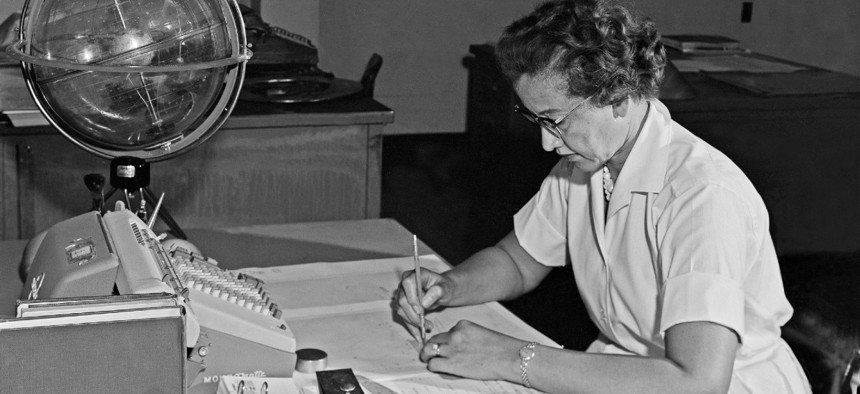The Legacy of a Hidden Figure

NASA mathematician Katherine Johnson is seen in 1962. NASA via AP
The stories of black women at the space agency were once buried so deep that it felt like a revelation when they were brought to light.
In 1958, not long after the pivotal launch of Sputnik, American engineers were preoccupied with spaceflight. Every day, engineers at the Langley laboratory, in Virginia, contemplated orbital mechanics, rocket propulsion, and the complicated art of leaving Earth—they needed to catch up with the Soviet Union. Katherine Johnson’s job was to prepare the equations and charts for this work. But she wasn’t allowed inside the room where any of it was discussed.
“Why can’t I go to the editorial meetings?” Johnson asked the engineers, as Margot Lee Shetterly wrote in the book Hidden Figures.
“Girls don’t go to the meetings,” her male colleagues told her.
“Is there a law against it?” she replied. There had been, in other cases; one prohibited black people from using the same bathroom as white people.
But Johnson already ignored those laws at the office, and she kept asking about the meetings. Eventually the engineers relented, tired of saying no over and over again. She made it into the room, and well beyond that.
Johnson, who died Monday at the age of 101, spent more than 30 years at NASA, where she provided the complex calculations for the country’s most important missions, from the first journey to the edge of space to the triumphant landing on the moon.
Johnson’s talent and contributions are well documented now, but for most of her life, her efforts went unrecognized—until Shetterly published her book in 2016, and the film it inspired became a blockbuster. For the first time, a wider swath of the world learned about Johnson and how she made a place for herself in American spaceflight. The book chronicled the lives of Johnson and the other black female mathematicians who worked as “computers” at the Langley Research Center, using pencils and slide rules to calculate equations for the agency that would become NASA.
The sciences are well known for their infuriating tendency to overlook important figures who aren’t white and male. But the stories of these women in particular had been buried so deep in the archives of history that when Shetterly brought them to light, it felt like a revelation. In her late 90s, Johnson was finally celebrated—widely and loudly—for her contributions to one of the most iconic accomplishments of the 20th century.
She was inundated with press coverage, had buildings renamed in her honor, and was awarded the Presidential Medal of Freedom. The burst of overdue recognition didn’t seem to faze her. “There’s nothing to it—I was just doing my job,” she said in a Washington Post interview in 2017. “They needed information and I had it, and it didn’t matter that I found it. At the time, it was just a question and an answer.”
Johnson was born on August 26, 1918, in White Sulphur Springs, West Virginia, to a schoolteacher and a farmer. She had a sharp mathematical mind as a child, and by the time she was 13 years old, she was taking classes at West Virginia State College, where she later earned her degree. She briefly attended West Virginia University to study for a master’s degree in math, becoming one of the first black students in the program, before leaving to start a family. She was teaching at a black public school in Virginia when a relative told her about job openings with Langley’s cadre of human computers, led by another black mathematician, Dorothy Vaughan.
Johnson arrived at Langley in 1953. At a place like Langley, any woman would have faced sexism in that era; Johnson and her colleagues had to confront the racism of the time, too. A cardboard sign on a cafeteria table, delineating where “colored computers” could sit, had been done away with by the time she got there, but the signage over the bathrooms remained. Johnson focused on her work. “She didn’t close her eyes to the racism that existed,” Shetterly wrote. “But she didn’t feel it in the same way. She wished it away, willed it out of existence inasmuch as her daily life was concerned.”
By 1958, the year NASA was formally established, Johnson was known for her keen eye and precision. As engineers considered what it would take to send the first American beyond the edge of space, she volunteered for work behind the scenes. “Tell me where you want the man to land, and I’ll tell you where to send him up,” Johnson told her boss. She ended up calculating the trajectory of Alan Shepard’s capsule from the time it lifted off the ground to the moment it splashed down in the Atlantic Ocean in 1961.
Johnson was called on to do the same for John Glenn, the first American to orbit Earth, the following year. This time, the equations that would control the journey had been programmed into actual computers, and the astronaut was a little nervous about entrusting his life to this newfangled technology. Glenn asked the engineers to tell Johnson to crunch the same numbers by hand and check them before the flight. They were correct. “If she says they’re good, then I’m ready to go,” he said.
As the space race between the United States and the Soviet Union escalated, Johnson contributed calculations that synchronized the Apollo 11 mission’s lander, which touched down on the lunar surface, and the command module, which remained in orbit around the moon while Neil Armstrong and Buzz Aldrin explored. Without these efforts, the first men on the moon wouldn’t have been able to find their way home.
Shetterly heard these and other stories of black mathematicians from her father, who worked as a scientist at Langley. During her early research for the book, the author shared some information about the women with experts on NASA history. “They encouraged what they viewed as a valuable addition to the body of knowledge, though some question the magnitude of the story. ‘How many women are we talking about? Five or six?’” Shetterly remembers them saying. By the time she finished her book, she had uncovered nearly 50 black women who had worked as computers, mathematicians, engineers, or scientists at the Langley facility from 1943 to 1980, and believed that “20 more names can be shaken loose from the archives with more research.”
While Johnson and her cohort of “computers” didn’t get the recognition they deserved at the height of the space race, their work has become part of the mythos of American spaceflight. But their story is also an object lesson in how history is written—who is included and who is not. The legacy that Johnson leaves behind is not just the equations she worked to help send astronauts safely up into space, all the way to the moon, and back again. Her story also reveals who gets left out of the stories America tells about its accomplishments. If Johnson and her colleagues are remembered, but the next group of “hidden figures” remains hidden, then we have not remembered her well enough.
NEXT STORY: Quick Hits




